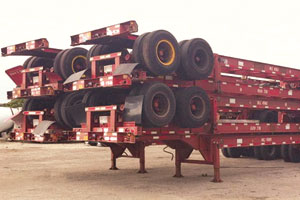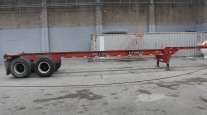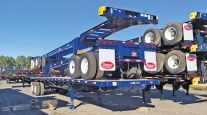Groups Say Parties Are Making Progress in Effort to Form N.Y.-N.J. Chassis Pool

Efforts to finally create a New York-New Jersey area chassis pool are ongoing as equipment providers, labor and port executives attempt to craft a workable approach to the thorny issue, trucking officials said.
“We’re still talking,” said Tom Adamski, who represented the New Jersey Motor Truck Association at an Aug. 4 meeting of a Port Authority of New York and New Jersey committee addressing chassis issues. “This is a big deal. It can’t get itself squared away overnight.”
“There are still some issues that labor has to sign on to. There are some other issues that [chassis] providers have to come together on,” Adamski said in an interview with Transport Topics. “I’d say we are still a couple of months away before we have something workable. The sooner we can get this done, the better it will be for everyone.”
The agency’s Port Performance Task Force group specializing in equipment originally targeted July 1 as the starting date for a pool to include 30,000 chassis. Work began more than a year ago to create a pool meant to speed shipments and improve productivity for truckers, ocean carriers, labor, chassis providers and terminal operators.
Chassis issues have been in flux since 2009, when ocean carriers began to shift the burden for supplying them to leasing companies, shippers and truckers. Until then, ocean carriers provided chassis to move their cargo. Everywhere else in the world, truckers own chassis.
“It was a very constructive meeting,” said Curtis Whalen, executive director of American Trucking Associations’ Intermodal Motor Carriers Conference. He stressed the importance of completing the pool project before the fall peak shipping season stresses the freight network.
Leasing companies, including TRAC Intermodal, Direct Chassis Link and Flexi-Van, are working out how the pool will be structured so that truckers can see how well it is working and how much of each providers chassis are being used.
“It all boils down to transparency,” he said.
The labor questions involve chassis inspections that dockworkers traditionally have done, Whalen explained.
Truckers believe the dockworkers shouldn’t do chassis inspections, which can slow down freight moves, because they aren’t party to leasing companies’ chassis use agreements with truckers.
“We have to collaborate more and have a more united system,” TRAC Intermodal CEO Keith Lovetro said on a television news program Aug. 5. “We have to coordinate with the marine terminal operators, with the chassis providers, with the unions in terms of gate operations. It’s becoming more integrated, and that takes a little time and that takes more communication.”
Other leasing companies and the International Longshoremen’s Association didn’t respond to TT’s requests for comment.
John Nardi, president of the New York Shipping Association, a management group composed of ocean carriers and terminal operators, said he expects to see specific proposals at a meeting Aug. 17 on what he calls “business issues,” such as determining when and how chassis are provided and to set standards for service and utilization.
The New York Shipping Association is in talks with the union on a contract extension.
“We made some good progress,” Nardi said of the group’s efforts so far.
“Nardi did a nice job in the meeting,” Whalen said. “It would make his future a lot better if they can get this [chassis] issue settled.”
While New York-New Jersey, the third-largest port complex, is working on a chassis deal, the ports of Los Angeles and Long Beach, California, the nation’s two largest container facilities, have had a pool in place since March.
That pool was formed after Direct Chassis Link and Flexi-Van received a ruling in September by the Justice Department that a Southern California pool wouldn’t violate antitrust rules. After that ruling, TRAC Intermodal joined that pool.
Adamski also said that the creation of the New York-New Jersey pool is hampered by the fact that the chassis transition is far from complete.
Some ocean carriers still insist that truckers use a specific chassis lessor. Others still own their own chassis. When ocean carriers don’t arrange door-to-door delivery, shippers or truckers have to get the cargo moved over the highway, further complicating the business relationships.
Staff Writer Daniel P. Bearth contributed to this report.




